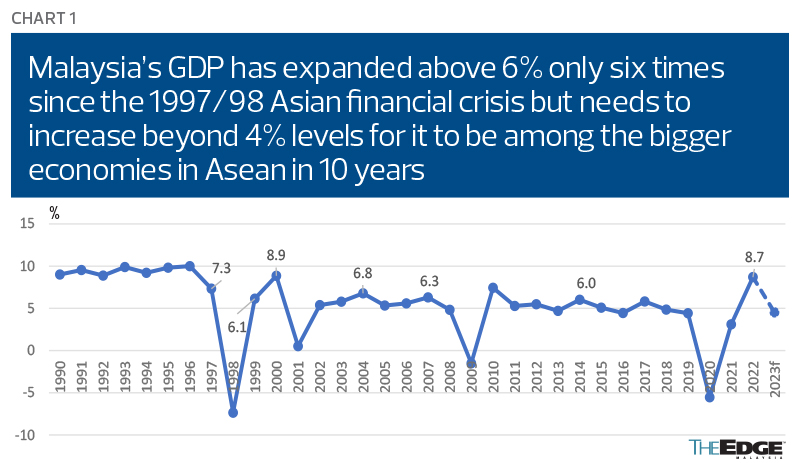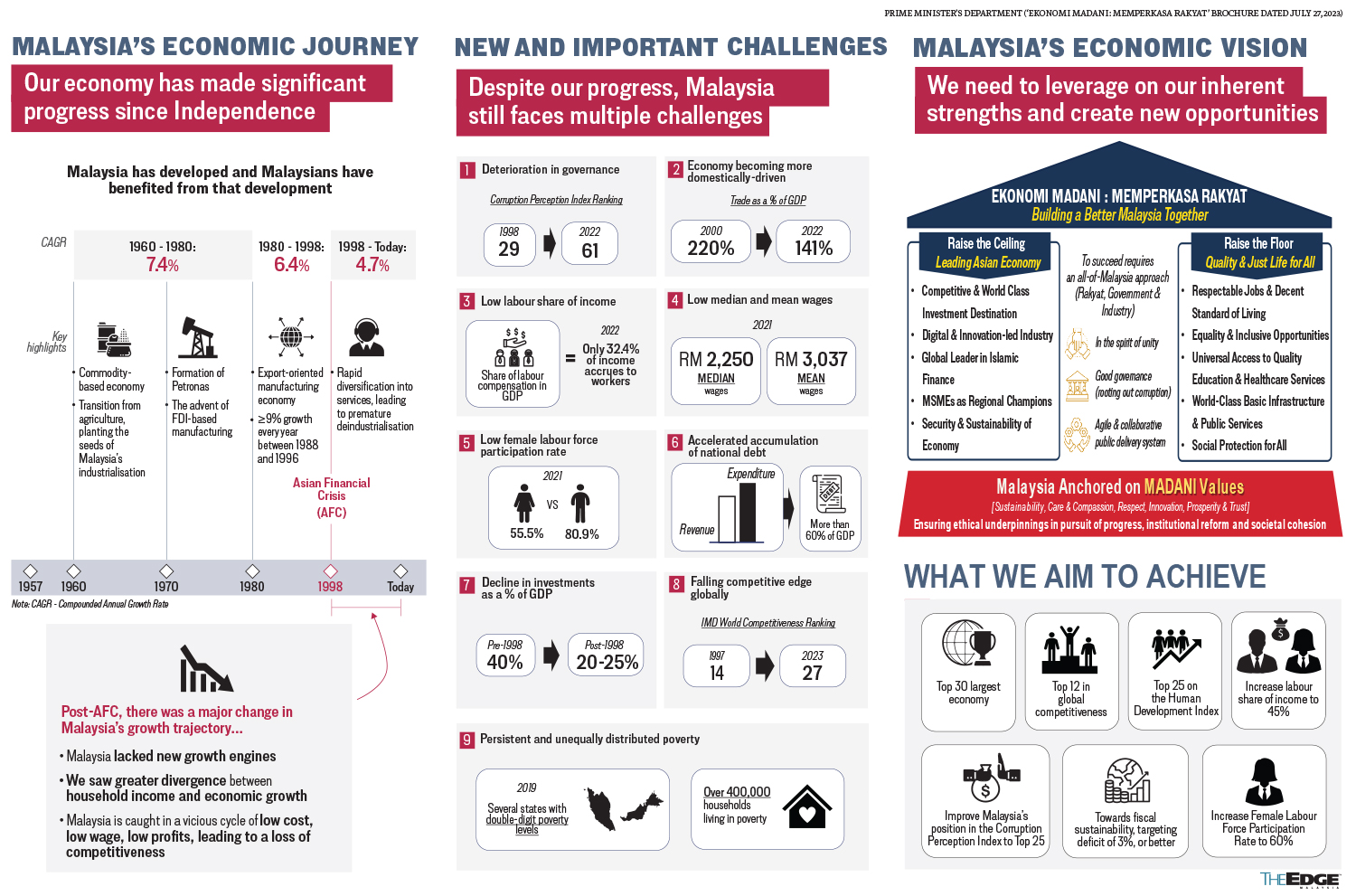This article first appeared in The Edge Malaysia Weekly on July 31, 2023 - August 6, 2023
IT is easy to dismiss Prime Minister Datuk Seri Anwar Ibrahim’s 80-minute “Madani Economy” speech on July 27 as a “pre-election mini budget” if one were to zero in on yet another round of RM100 to RM300 cash transfers to the lower- and middle-income wage earners and civil servants as well as pensioners. That, however, would be a huge disservice to self and country at a critical juncture in the nation’s development where a whole-of-nation approach is needed to ensure a sustainable future and equitable opportunities for all.
Unlike in 1991, when Malaysia’s Vision 2020 was unveiled, we can no longer wait 30 years to become a developed nation in every sense of the word.
By 2043, less than two decades from now, Malaysia will be an “aged” nation. And if the right kind of reforms do not take place speedily, the manure could hit the ceiling earlier. If the growth in federal government revenue continues to trail the growth in expenses the way it has the past 10 years, The Edge has previously calculated that Putrajaya’s annual receipts may be insufficient to cover its debt service charges as well as civil service emoluments and pension by 2040.
This time, the working timeline has therefore been shortened by two-thirds to just 10 years.
While Anwar laid out seven economic mission-targets in his “Madani Economy” speech, the bullseye, if you will, should be on the first goal under “what we aim to achieve” — making Malaysia one of the world’s 30 largest economies by 2033.
For that to happen, Malaysia needs to be globally competitive, have excellent human development, be perceived by investors as very clean (instead of a highly corrupt kleptocracy), have fiscal flexibility to make counter-cycle spending where necessary and have a better-compensated skilled labour force that can weather price pressures and one where more women find it easier to participate and remain in — all of which are encompassed in the remaining six things that “we aim to achieve”: being top 12 in global competitiveness; top 25 on the Human Development Index (HDI) as well as the Corruption Perception Index; increase labour share of income to 45% (from 32.4% in 2022); work towards fiscal sustainability by targeting a budget deficit of 3% of gross domestic product (GDP) or less; and raising the female labour force participation to 60% (from 55.5% in 2021).
All that should help shore up investments as well as revitalise GDP growth rates, which have underwhelmed following the 1997/98 Asian financial crisis (AFC) as the country slipped into a vicious “low cost, low wage and low profits” cycle that eroded Malaysia’s competitiveness.
“If we are satisfied with the current position, our economy will continue to record growth of 4% to 5%. But if we work hard and implement reforms, we can achieve 5.5%. In fact, I believe it is not impossible to generate growth of 6%,” Anwar said in his speech.
“Growing the 6% per annum is important because we can double the size of GDP within a decade whereas growing at 5% means we would need 15 years to achieve that same target,” Deputy Minister of Investment, Trade and Industry Liew Chin Tong wrote in a blog post dated July 27 in support of the prime minister’s speech.
Seasoned economists would remember that to achieve Vision 2020, Malaysia had wanted GDP growth to average above 7% a year, which was the average growth between 1960 and 1980.
“During that period, the rakyat benefited from abundant resources as economic growth and income increases were aligned. However, the AFC widened the gap between economic growth and income, leading [to a continuous decline],” Anwar said in his speech.
Since the AFC, official data shows that Malaysia’s GDP growth had only exceeded 6% per annum in six of the ensuing 24 years to date, including last year’s post-Covid-19 rebound to 8.7% (see chart 1).
A growth rate of 4% or lower would likely see Malaysia’s economic ranking slip further among Asean peers. Vietnam’s GDP in US dollar terms, which was smaller than Malaysia’s in 2021, was slightly bigger than Malaysia’s in 2022, according to World Bank data. That is one year earlier than a 2021 projection made by Statista that expected Vietnam’s economy to overtake Malaysia’s in 2023 by about US$2 billion (RM9.1 billion) (which is around the difference in 2022).
By 2028, though, that same Statista prediction expects the gap to significantly widen to about US$90 billion with Vietnam’s GDP seen at US$725 billion versus Malaysia’s US$635 billion, still just behind Singapore’s US$641 billion. Vietnam’s gain could well be premised on a larger pool of middle-income consumers with its population (97.47 million in 2021) being three times that of Malaysia’s.
To be among the world’s Top 30 largest economies, Malaysia will need to move up the value chain in terms of economic complexity and possibly overtake even Singapore and Vietnam, at No 33 and No 35 respectively in 2022, versus Malaysia’s No 36, according to World Bank data (excluding Venezuela, which was ranked No 30 using 2014 data).
Apart from being among the world’s top 30 largest economies, Singapore, with only 5.5 million people or one-sixth of Malaysia’s population, has attained Malaysia’s mission-target in terms of HDI value, the IMD World Competitiveness Index as well as the Corruption Perception Index (see tables on Page 58).
“We must implement reforms so that Malaysia can be ranked among the 12 best economies in terms of competitiveness and ease of doing business. It should be announced to all corners of the world that Malaysia is open and ready to welcome investors and businesses,” Anwar said, acknowledging investment commitments from Japan’s Sumitomo Corp, US-based Tesla, China’s Rongsheng and South Korea’s Samsung Engineering. Domestic direct investments (DDI) will also be a key performance indicator when it comes to Malaysia’s investment achievements, he added.
And not only do reforms need to happen, they also need to be institutionalised to stop the country from slipping back to old ways where only a few elites rather than the majority benefited from the system.
Rather than focusing on sectors, Malaysia is taking a mission-based approach as it seeks to reinvigorate investments, which had post-1998 halved from 40% of GDP before the AFC.
To gain the desired all-of-Malaysia buy-in, Anwar chose to round up his speech by announcing that “each ministry will announce more specific initiatives to welcome the launch of the Madani Economy, which essentially seeks to ‘Empower the People’”.
Much of what needs to be done for the Madani Economy to succeed are essentially necessary reforms that did not happen fast enough for the realisation of Vision 2020. As the current administration embarks on a mission-based approach to lift the country’s economic standing on the global stage and solve problems that matter to the people, policy action will need to be coherent and consistent to ensure Malaysia has a much better standing in the coming decade.
Save by subscribing to us for your print and/or digital copy.
P/S: The Edge is also available on Apple's App Store and Android's Google Play.
- Maybank customers can now make QR payments through MAE app in Cambodia
- Malaysian semiconductor stocks fall amid US probes, software firms steady
- HRD Corp's chief executive Shahul Hameed steps down, confirming The Edge report
- U Mobile to roll out 5G network with Huawei, ZTE; sees 'similar' rates to DNB
- Malaysia to bear brunt of weaker exports to US, Macquarie flags
- RHB confirms named as defendant in RM313m Taman U-Thant suit, to contest claims
- US copper industry seeks export curbs instead of import tariffs
- Gas supply restoration in Putra Heights expected by July 1 at the earliest, says Petronas Gas
- Applied Materials takes 9% stake in chip-gear partner Besi
- China sees another ‘50 golden years’ with Malaysia, says Xi






